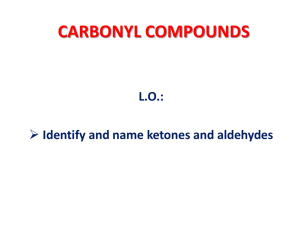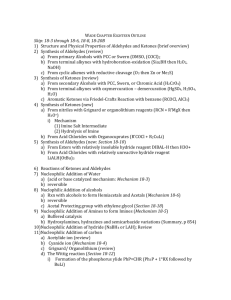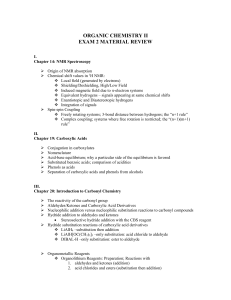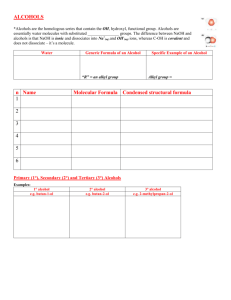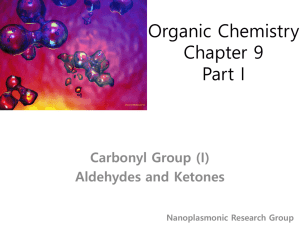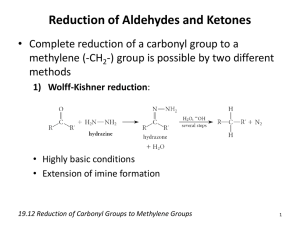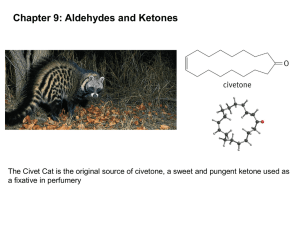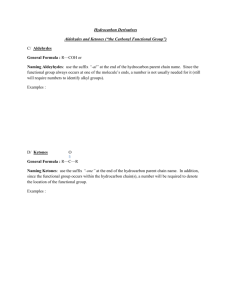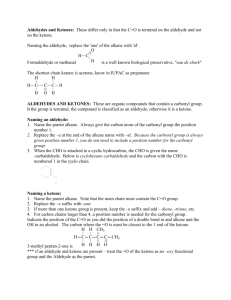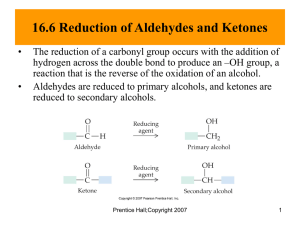10.5 Carbonyl Compounds (a) describe: (i) the
advertisement
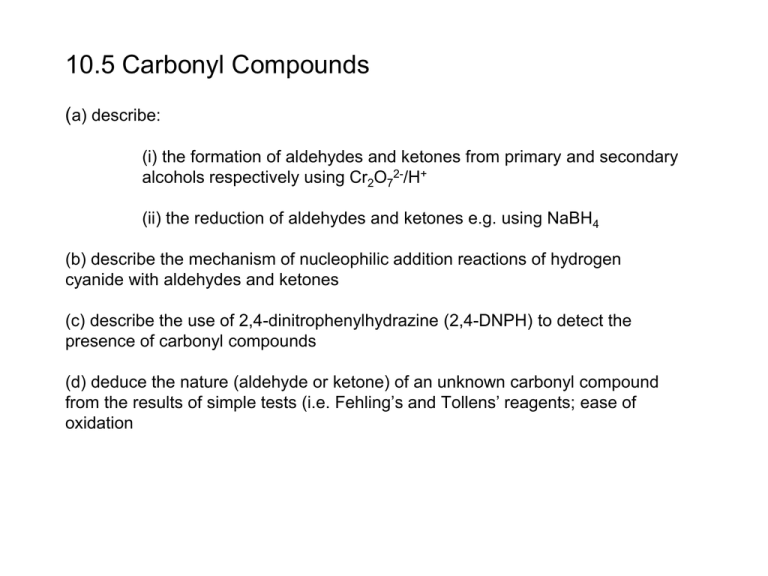
10.5 Carbonyl Compounds (a) describe: (i) the formation of aldehydes and ketones from primary and secondary alcohols respectively using Cr2O72-/H+ (ii) the reduction of aldehydes and ketones e.g. using NaBH4 (b) describe the mechanism of nucleophilic addition reactions of hydrogen cyanide with aldehydes and ketones (c) describe the use of 2,4-dinitrophenylhydrazine (2,4-DNPH) to detect the presence of carbonyl compounds (d) deduce the nature (aldehyde or ketone) of an unknown carbonyl compound from the results of simple tests (i.e. Fehling’s and Tollens’ reagents; ease of oxidation Revision: formation of aldehydes and ketones from alcohols; Primary alcohols give aldehydes: Ethanol Ethanal Secondary alcohols give ketones: Aldehydes are names systematically with al at the end of the name and ketones with one; remember to include the number e.g. butan-2-one. Reduction of aldehydes and ketones Lithium aluminium hydride (tetrahydridoaluminate) and sodium borohydride (tetrahydridoborate) reduce aldehydes and ketones to primary and secondary alcohols. Sodium borohydride can be dissolved in water (some carbonyl compounds are soluble in water), but lithium aluminium hydride reacts with water, so apolar solvents like ethers are used. Nucleophilic addition of hydrogen cyanide to carbonyl compounds Hydrogen cyanide adds across the double bond of carbonyl compounds to form hydroxynitriles (cyanohydrins). It is an example of nucleophilic addition using a cyanide ion nucleophile: CH3COCH3 + HCN CH3COH(CN)CH3 In this reaction sodium cyanide is mixed with dilute acids in aqueous solution to generate HCN which immediately reacts with the carbonyl compounds; pH about 5. Mechanism of Addition + nucleophilic addition O H3 C CH3 O CN H3C H3O+ HO CN H3 C CH3 CH3 cyanohydrin CN- cyanohydrin formation; a new carbon-carbon bond formed Notice the polar carbonyl compound to be attacked by the nucleophile (CN-) and the relative ease of breaking the C=O double bond (p-bond) as oxygen accepts the negative charge. Remember, aldehydes often produce chiral centres (*), but normally in equal amounts of optical isomers. nucleophilic addition O CN- + H CH3 O CN H H3O+ CH3 HO CN H * CH3 cyanohydrin cyanohydrin formation; chiral centre generated Use of 2,4-Dinitrophenylhydrazine (2,4-DNPH) A method of identification of a carbonyl compound is to make a coloured crystalline solid derivative. They are easily prepared by mixing the carbonyl compound with an acid solution of 2,4-DNPH in methanol. R H H N N R C O + R' NO2 H+ H C H N N NO2 + R' NO2 R, R' = alkyl 2,4-DNPH H2O NO2 an orange-coloured hydrazone formed Different carbonyl compounds (R, R’ differ in number of carbon/hydrogen atoms) have different melting points. This is a nucleophilic addition then elimination (of water) type of reaction to give the hydrazone. To distinguish between an aldehyde and ketone 1. Fehling’s solutions Fehling’s solution A (containing Cu2+) and Fehlings solution B (containing an alkali and a complexing agent) are warmed with the aldehyde to oxidize it to the carboxylic acid; meanwhile the Cu2+ is reduced to copper (I) oxide Cu2O seen as an insoluble red precipitate. There’s no reaction with ketones. NaOH(aq), methanol RCHO + Cu2+(aq) RCOOH + Cu2O(s) complexing agent Silver mirror test Aldehydes are oxidized by Ag+ ions in aqueous ammonia (Tollen’s reagent); the aldehyde is oxidized to the carboxylic acid and silver reduced to metallic silver deposited as a silver mirror around the flask. The mixture is warmed. NH3(aq) RCHO + Ag+(aq) RCOOH + Ag(s) Silver mirror (a) Name and draw the full structures of one ketone A and one aldehyde B, each with formula C5H10O. (b) Describe a simple chemical teast which would enable you to differentiate between samples of A and B. State the observations you would expect to make for each sample and explain the chemistry involved. (c) For the reaction of your aldehyde B with HCN, give: (i) the equation (ii) the mechanism.
